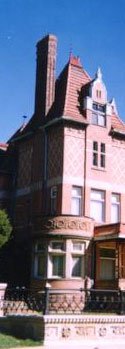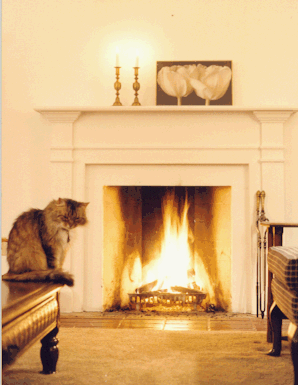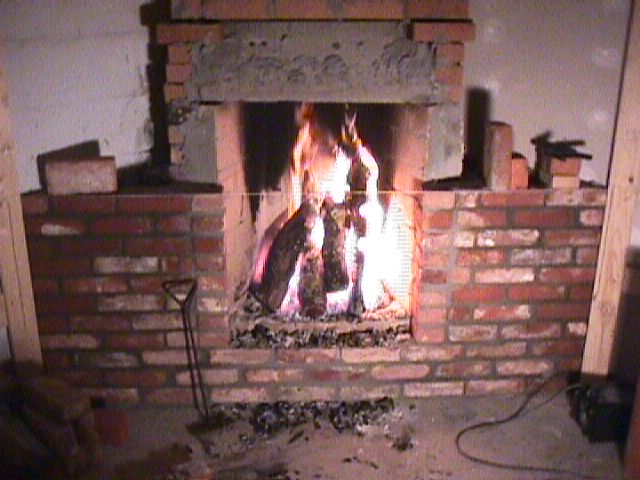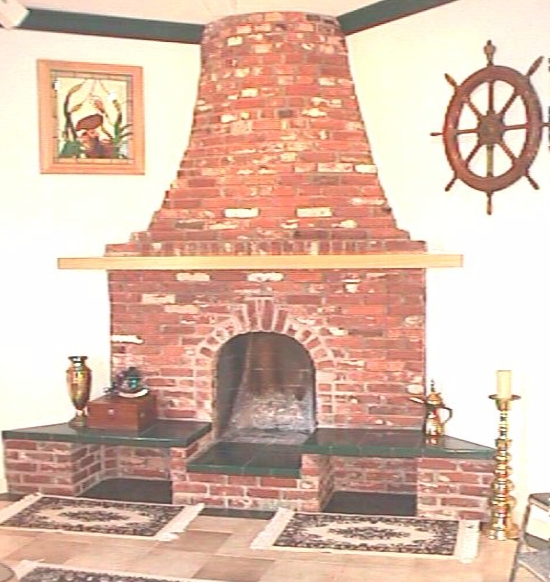(Deep and inefficient, just like they were before Rumford)
|
Barring a gross code violation, open fireplaces are pretty safe. Lots of dilution air flows in the face cooling the whole system so that flue temperatures are typically under 300 degrees F - a hundred degrees or so cooler than typical stove flue temperatures. All that dilution air also means the fire has all the air it needs for complete combustion. Rarely do fireplaces send unburned gasses up the chimney to condense as creosote and, as a result, chimney fires are rare in chimneys serving fireplaces. |
|
|
The two danger zones are behind the firebox and the frame lintel above the fireplace opening. Code requires fireboxes to be at least 8" thick. In addition the outside of the masonry must be at least 2" clear of combustible materials. (The NFPA and the new ICC codes require 4" of clearance.) But this clearance is often misunderstood or compromised. A builder will fill the space with insulation. Base boards, flooring, cabinets will be built against the back wall. We routinely advise our customers to build the fireback 12" thick as an extra precaution which, by the way, is another advantage of "Rumfordization" - building the shallow Rumford box inside a deeper firebox results in a thicker fireback wall. The lintel in a frame wall above the opening is probably okay if it's up to code - 2" clear of an 8" thick throat or smoke chamber wall. Often, however, it's an insidious hazard in that you may not be able to tell if the header was a little too low and the masson compromised on the wall thickness and clearances. Sometimes, with a floor to ceiling masonry front, it's even hard to tell there's a frame wall buried in there somewhere. In the 1980's the senior code engineer at BOCA routinly advised builders that it was okay to substitute brick thickness for the airspace. This inspired hot debates but I think he was essentially correct. Maybe six inches of brick is not as safe as four inches of brick and a two inch air space. But how about eight inches? Twelve inches? Masonry is a poor insulator but we know that thicker masonry walls take longer to heat up and disappate heat better. Getting the combustible material out of the way is best. Air spaces are misunderstood, often compromised and some say unbuildable. Insulation works but in modern times with ubiquitous balloon frame construction, insulation has become the only strategy. Historically wall thickness and mass were shown to work well as fire prevention strategies. |
|
Modern codes require flue linings but that wasn't always the case. In fact some codes until as recently as 1980 allowed chimneys to be unlined if they had solid masonry walls at least 8" thick. This dates from Victorian times when successful fire prevention strategies depended on thickness and mass rather than insulation. So, your customer has eight fireplaces in a Victorian mansion with fancy multi-flue chimneys that are in contact with combustble framing but with walls that thicken to 8" as they pass through the floors and roof line. Moreover the brickwork and the flues, with parged mortar linings, seem to be in good condition. Do these chimneys need to be lined? Do they need to be lined with an insulating lining system compliant with UL 1777? If so, is that becasue you think the chimneys are unsafe or is your decision motivated by concerns about liability? What if the largest insulated liner you can install would not be large enough to vent the fireplace? Do you know that most of the metal chimney liner systems listed to UL1777 are sold without the required insulating blankets?
|

|
|
I don't really have answers. I think the chimneys described above are safe. Even if they were deteriorating, I think they could be made safe by sleeving them with an un-listed single wall stainless steel liner. But I don't want to incure unnecessary risk either and I know there are some situations (single flue minimal 4" thick chimneys in contact with combustibles) that are definitely unsafe unless lined with a insulated lining system. What I really think is that together we should re-think the issue of relining old chimneys and re-examine historic strategies based on thickness and mass so we can write better code. Sweeps who reline chimneys would be the beneficiaries. If you're installing listed lining systems without the required insulation (which I have to assume you are since most of the listed pipe is sold without the insulation, which voids the listing) you're taking on too much risk even if, as I assume, you're making judgements, as I would, that the insulation isn't alwyas necessary for safety. |
|
Rumfordizing fireplaces requires judgement as well as knowlege of code and safety issues - oh, and a monicum of skill at several crafts - but many sweeps are up to the task. Rumfordizing a fireplace is easy - build the firebox to reflect heat and make the throat streamlined and the right size, following Rumford's "Practical Directions designed for the Use of Workmen". The main delemma is an overly restictive and historically blind code that prevents the use of many old chimneys unless expensively relined rendering them too small to work. I invite your suggestions and support. I leave you with a poem written by one of my boat-building customers so intent on saving money that he poured his throat out of concrete rather than buy mine: |

Buckley Rumford Fireplaces
Copyright 1996 - 2010 Jim Buckley
All rights reserved.
webmaster


